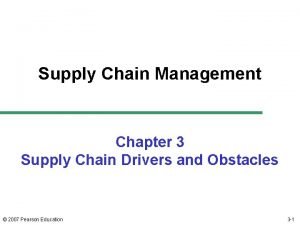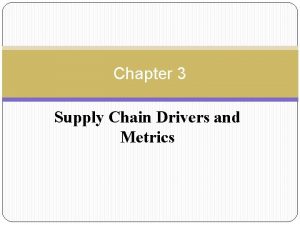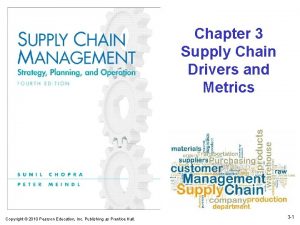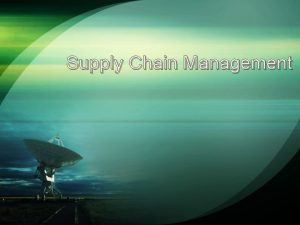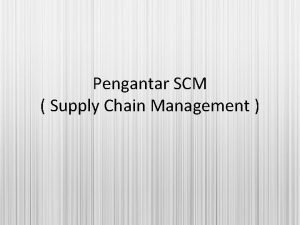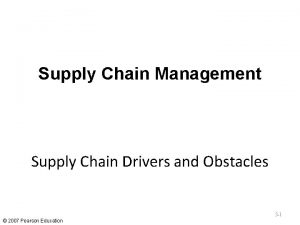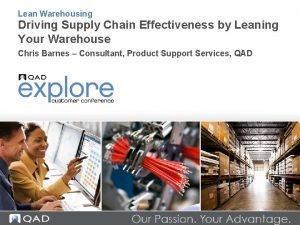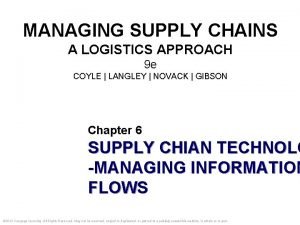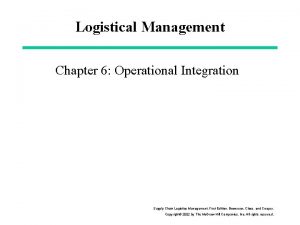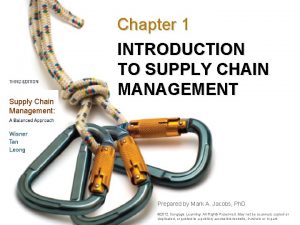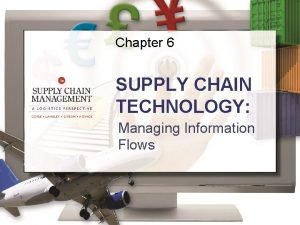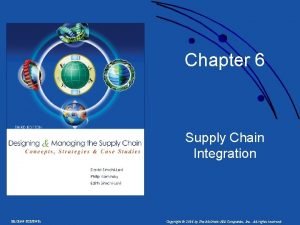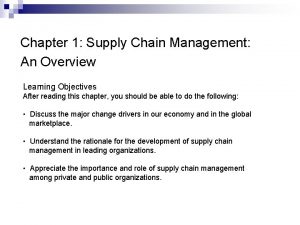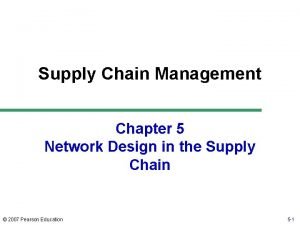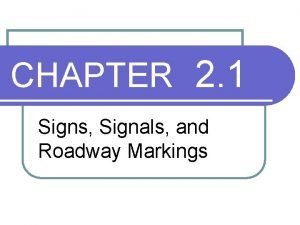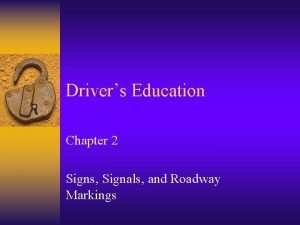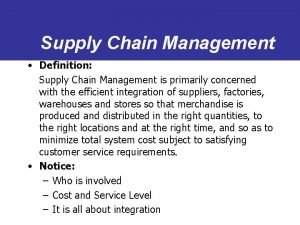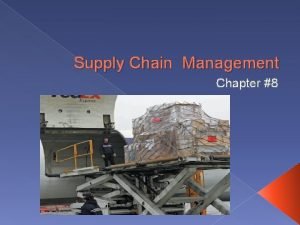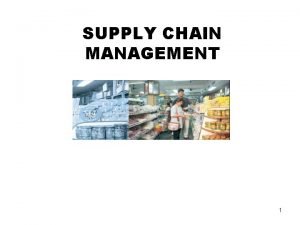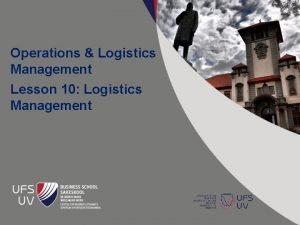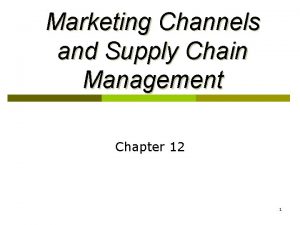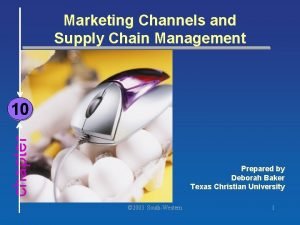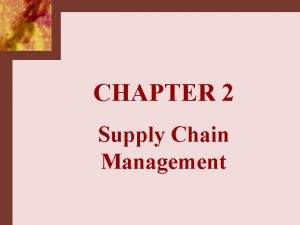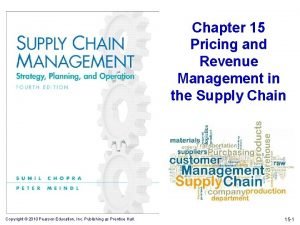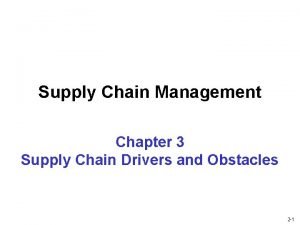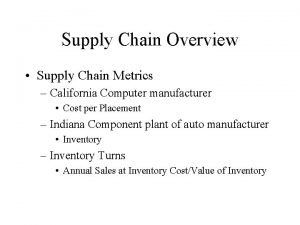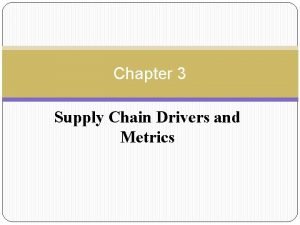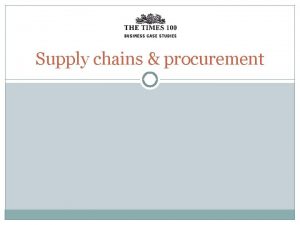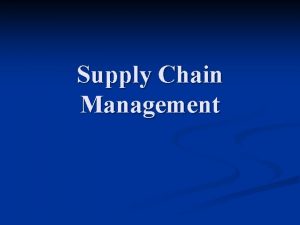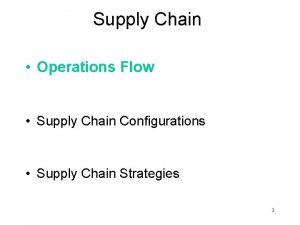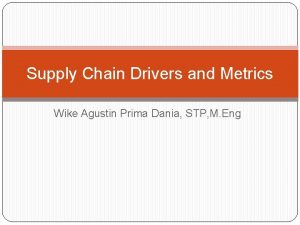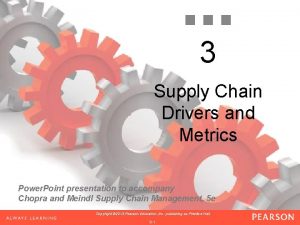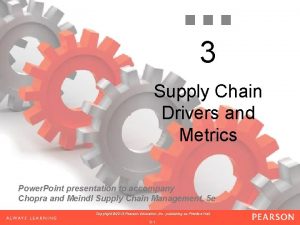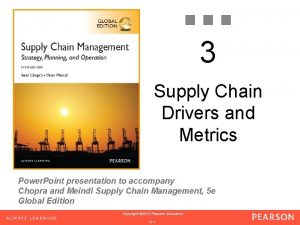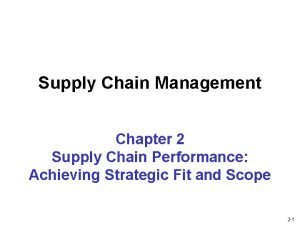Chapter 3 Supply Chain Drivers and Metrics Copyright






























- Slides: 30

Chapter 3 Supply Chain Drivers and Metrics Copyright © 2010 Pearson Education, Inc. Publishing as Prentice Hall. 3 -1

Outline u Impellers of Supply Chain u Supply Chain Concepts u Drivers of supply chain performance u A framework for structuring drivers u Facilities u Inventory u Transportation u Information u Sourcing u Pricing u Obstacles to achieving fit Copyright © 2010 Pearson Education, Inc. Publishing as Prentice Hall. 3 -2

IMPELLERS OF SUPPLY CHAIN u. Empowered Customer u. Developments in Information Technology Tools u. Globalisation Copyright © 2010 Pearson Education, Inc. Publishing as Prentice Hall. 3 -3

SUPPLY CHAIN CONCEPTS u. Systems Concept u. Total Cost Concept u. Trade off Concept Copyright © 2010 Pearson Education, Inc. Publishing as Prentice Hall. 3 -4

Drivers of Supply Chain Performance u Facilities – places where inventory is stored, assembled, or fabricated – production sites and storage sites u Inventory – raw materials, WIP, finished goods within a supply chain – inventory policies u Transportation – moving inventory from point to point in a supply chain – combinations of transportation modes and routes u Information – data and analysis regarding inventory, transportation, facilities throughout the supply chain – potentially the biggest driver of supply chain performance u Sourcing – functions a firm performs and functions that are outsourced u Pricing – Price associated with goods and services provided by a firm to the supply chain Copyright © 2010 Pearson Education, Inc. Publishing as Prentice Hall. 3 -5

A Framework for Structuring Drivers Copyright © 2010 Pearson Education, Inc. Publishing as Prentice Hall. 3 -6

Facilities u. Role in the supply chain – the “where” of the supply chain – manufacturing or storage (warehouses) u. Role in the competitive strategy – economies of scale (efficiency priority) – larger number of smaller facilities (responsiveness priority) u. Example 3. 1: Toyota and Honda u. Components of facilities decisions Copyright © 2010 Pearson Education, Inc. Publishing as Prentice Hall. 3 -7

Components of Facilities Decisions u. Location – centralization (efficiency) vs. decentralization (responsiveness) – other factors to consider (e. g. , proximity to customers) u. Capacity (flexibility versus efficiency) u. Manufacturing methodology (product focused versus process focused) u. Warehousing methodology (SKU storage, job lot storage, cross-docking) u. Overall trade-off: Responsiveness versus efficiency Copyright © 2010 Pearson Education, Inc. Publishing as Prentice Hall. 3 -8

Inventory u. Role in the supply chain u. Role in the competitive strategy u. Components of inventory decisions Copyright © 2010 Pearson Education, Inc. Publishing as Prentice Hall. 3 -9

Inventory: Role in the Supply Chain u. Inventory exists because of a mismatch between supply and demand u. Source of cost and influence on responsiveness u. Impact on – material flow time: time elapsed between when material enters the supply chain to when it exits the supply chain – throughput » » » rate at which sales to end consumers occur I = DT (Little’s Law) I = inventory; D = throughput; T = flow time Example Inventory and throughput are “synonymous” in a supply chain Copyright © 2010 Pearson Education, Inc. Publishing as Prentice Hall. 3 -10

Inventory: Role in Competitive Strategy u. If responsiveness is a strategic competitive priority, a firm can locate larger amounts of inventory closer to customers u. If cost is more important, inventory can be reduced to make the firm more efficient u. Trade-off u. Example 3. 2 – Nordstrom Copyright © 2010 Pearson Education, Inc. Publishing as Prentice Hall. 3 -11

Components of Inventory Decisions u Cycle inventory – Average amount of inventory used to satisfy demand between shipments – Depends on lot size u Safety inventory – inventory held in case demand exceeds expectations – costs of carrying too much inventory versus cost of losing sales u Seasonal inventory – inventory built up to counter predictable variability in demand – cost of carrying additional inventory versus cost of flexible production u Overall trade-off: Responsiveness versus efficiency – more inventory: greater responsiveness but greater cost – less inventory: lower cost but lower responsiveness Copyright © 2010 Pearson Education, Inc. Publishing as Prentice Hall. 3 -12

Transportation u. Role in the supply chain u. Role in the competitive strategy u. Components of transportation decisions Copyright © 2010 Pearson Education, Inc. Publishing as Prentice Hall. 3 -13

Transportation: Role in the Supply Chain u. Moves the product between stages in the supply chain u. Impact on responsiveness and efficiency u. Faster transportation allows greater responsiveness but lower efficiency u. Also affects inventory and facilities Copyright © 2010 Pearson Education, Inc. Publishing as Prentice Hall. 3 -14

Transportation: Role in the Competitive Strategy u. If responsiveness is a strategic competitive priority, then faster transportation modes can provide greater responsiveness to customers who are willing to pay for it u. Can also use slower transportation modes for customers whose priority is price (cost) u. Can also consider both inventory and transportation to find the right balance u. Example 3. 3: Blue Nile Copyright © 2010 Pearson Education, Inc. Publishing as Prentice Hall. 3 -15

Components of Transportation Decisions u. Mode of transportation: – air, truck, rail, ship, pipeline, electronic transportation – vary in cost, speed, size of shipment, flexibility u. Route and network selection – route: path along which a product is shipped – network: collection of locations and routes u. In-house or outsource u. Overall trade-off: Responsiveness versus efficiency Copyright © 2010 Pearson Education, Inc. Publishing as Prentice Hall. 3 -16

Information u. Role in the supply chain u. Role in the competitive strategy u. Components of information decisions Copyright © 2010 Pearson Education, Inc. Publishing as Prentice Hall. 3 -17

Information: Role in the Supply Chain u. The connection between the various stages in the supply chain – allows coordination between stages u. Crucial to daily operation of each stage in a supply chain – e. g. , production scheduling, inventory levels Copyright © 2010 Pearson Education, Inc. Publishing as Prentice Hall. 3 -18

Information: Role in the Competitive Strategy u. Allows supply chain to become more efficient and more responsive at the same time (reduces the need for a trade-off) u. Information technology u. What information is most valuable? u. Example 3. 4: Andersen Windows u. Example 3. 5: Sunsweet Growers Copyright © 2010 Pearson Education, Inc. Publishing as Prentice Hall. 3 -19

Components of Information Decisions u. Push (MRP) versus pull (demand information transmitted quickly throughout the supply chain) u. Coordination and information sharing u. Forecasting and aggregate planning u. Enabling technologies – – EDI Internet ERP systems Supply Chain Management software u. Overall trade-off: Responsiveness versus efficiency Copyright © 2010 Pearson Education, Inc. Publishing as Prentice Hall. 3 -20

Sourcing u. Role in the supply chain u. Role in the competitive strategy u. Components of sourcing decisions Copyright © 2010 Pearson Education, Inc. Publishing as Prentice Hall. 3 -21

Sourcing: Role in the Supply Chain u. Set of business processes required to purchase goods and services in a supply chain u. Supplier selection, single vs. multiple suppliers, contract negotiation Copyright © 2010 Pearson Education, Inc. Publishing as Prentice Hall. 3 -22

Sourcing: Role in the Competitive Strategy u. Sourcing decisions are crucial because they affect the level of efficiency and responsiveness in a supply chain u. In-house vs. outsource decisions- improving efficiency and responsiveness u. Example 3. 6: Cisco Copyright © 2010 Pearson Education, Inc. Publishing as Prentice Hall. 3 -23

Components of Sourcing Decisions u. In-house versus outsource decisions u. Supplier evaluation and selection u. Procurement process u. Overall trade-off: Increase the supply chain profits Copyright © 2010 Pearson Education, Inc. Publishing as Prentice Hall. 3 -24

Pricing u. Role in the supply chain u. Role in the competitive strategy u. Components of pricing decisions Copyright © 2010 Pearson Education, Inc. Publishing as Prentice Hall. 3 -25

Pricing: Role in the Supply Chain u. Pricing determines the amount to charge customers in a supply chain u. Pricing strategies can be used to match demand supply Copyright © 2010 Pearson Education, Inc. Publishing as Prentice Hall. 3 -26

Sourcing: Role in the Competitive Strategy u. Firms can utilize optimal pricing strategies to improve efficiency and responsiveness u. Low price and low product availability; vary prices by response times u. Example 3. 7: Amazon. com Copyright © 2010 Pearson Education, Inc. Publishing as Prentice Hall. 3 -27

Components of Pricing Decisions u. Pricing and economies of scale u. Everyday low pricing versus high-low pricing u. Fixed price versus menu pricing u. Overall trade-off: Increase the firm profits Copyright © 2010 Pearson Education, Inc. Publishing as Prentice Hall. 3 -28

Obstacles to Achieving Strategic Fit u. Increasing variety of products u. Decreasing product life cycles u. Increasingly demanding customers u. Fragmentation of supply chain ownership u. Globalization u. Difficulty executing new strategies Copyright © 2010 Pearson Education, Inc. Publishing as Prentice Hall. 3 -29

Summary u. What are the major drivers of supply chain performance? u. What is the role of each driver in creating strategic fit between supply chain strategy and competitive strategy (or between implied demand uncertainty and supply chain responsiveness)? u. What are the major obstacles to achieving strategic fit? u. In the remainder of the course, we will learn how to make decisions with respect to these drivers in order to achieve strategic fit and surmount these obstacles Copyright © 2010 Pearson Education, Inc. Publishing as Prentice Hall. 3 -30
 Drivers in supply chain
Drivers in supply chain What is supply chain drivers
What is supply chain drivers 6 drivers of supply chain management
6 drivers of supply chain management Supply chain drivers and metrics
Supply chain drivers and metrics Supply chain drivers and obstacles
Supply chain drivers and obstacles Supply chain drivers and obstacles
Supply chain drivers and obstacles Drivers of supply chain management
Drivers of supply chain management Lean warehousing definition
Lean warehousing definition Six drivers of supply chain excellence
Six drivers of supply chain excellence Matching supply and demand in supply chain
Matching supply and demand in supply chain Value chain and supply chain difference
Value chain and supply chain difference Eltonian pyramid
Eltonian pyramid Chapter 5 section 1 supply and the law of supply
Chapter 5 section 1 supply and the law of supply Chapter 6 supply chain management
Chapter 6 supply chain management Chapter 1 supply chain management
Chapter 1 supply chain management Chapter 6 supply chain management
Chapter 6 supply chain management Dell supply chain case study
Dell supply chain case study Chapter 1 supply chain management
Chapter 1 supply chain management Network design in the supply chain chapter 5
Network design in the supply chain chapter 5 A traffic-control officer's signal
A traffic-control officer's signal Chapter 2 signs, signals, and roadway markings
Chapter 2 signs, signals, and roadway markings Drivers ed chapter 2 signs signals and roadway markings
Drivers ed chapter 2 signs signals and roadway markings Supply chain management explanation
Supply chain management explanation Order promising module of supply chain management
Order promising module of supply chain management Replenishment cycle in supply chain
Replenishment cycle in supply chain Logistics management introduction
Logistics management introduction The network made up of the company suppliers distributors
The network made up of the company suppliers distributors Marketing channels and supply chain management
Marketing channels and supply chain management What is crm in supply chain management
What is crm in supply chain management Total cost concept in supply chain management
Total cost concept in supply chain management Role of pricing and revenue management in a supply chain
Role of pricing and revenue management in a supply chain
